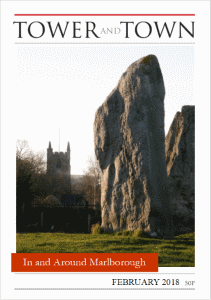

Tower and Town, February 2018 (view the full edition) (view the full edition)Aspects Of AveburyHere in Marlborough we are incredibly fortunate to have on our doorstep Avebury, not only a delightful small village containing a superb small Tudor manor house, but the site of one of the great monuments of the prehistoric world, with its massive stone circle, or henge, and a wealth of remarkable Neolithic and Bronze Age sites in the surrounding landscape. It is easy when visiting Avebury to assume that what you see has always been there, timeless, unchanging. Yet constant change is more the true story. When the archaeologist Alexander Keiller arrived in Avebury in 1925, prior to his reconstruction work on the henge, only 15 of the original total of nearly 200 stones in the outer & inner circles remained standing. Time had accounted for some, many were (and some still are) buried, most likely in pursuance of early Christian edicts that ‘any stone used in any act of pagan worship should be destroyed or buried’; and many went into the fabric of the buildings and walls of the village once the local population honed the skills of stone-breaking. Much of the stone destruction occurred during the post-Civil War period of the 17th and early 18th centuries. During this time Avebury became a thriving centre for a Nonconformist chapel community, encouraged by the Five Mile Act of 1665 under which dissenting ministers were forbidden from preaching within 5 miles of their previous benefices. Avebury thus established a ‘Five Mile Chapel’ in 1670, with a growing congregation of dissenters from Marlborough, Devizes, and Calne – all more than 5 miles distant. However, members of this community were themselves instrumental in the continuing destruction of the henge, and the fabric of today’s delightful and evocative Avebury Chapel almost certainly contains fragments of ancient stones from the monument. Sadly this community has dwindled, but although worship has now ceased the future of the Chapel appears safe. The National Trust have recently acquired this historic building and plan to use it not only for local groups but as a base from which to support their membership and promote the World Heritage Site, and as a start point for many of the Trust’s trails and archaeological walks. To the rear of the Chapel sits the Quiet Garden, an enchanting, peaceful space with an unrivalled view over the southern Inner Circle. And it is here, through the wonders of modern archaeological techniques, that a major and intriguing discovery was made in 2017. Ground-penetrating radar has just revealed evidence of a much earlier development, a square shaped formation appearing to contain a building or dwelling within the enigmatic stone settings of this part of the monument. The evidence is still being evaluated but is pointing towards a significant phase of construction and possible habitation in the first half of the 4th millennium BC, a date for the origins of the henge several centuries earlier than previously believed. So opens another chapter in our understanding of this unique monument. Dick Whitfield |